Really strange problem I'm having here.
Basically, the user comes to a View that has a TableView attached to it. There's a call to the backend for some data, and in the completion block of that data is provided to the TableView to display.
In cellForRow 1 of 4 reusable, custom cells is dequeued, based on some logic, and then a configure method for that cell is called.
Here's where it gets tricky: Some of the cells might require further asynchronous calls (to fetch more data for their custom displays), thus required a tableView.reloadRows call...What's happening, then, is best explained by these two screenshots:
In the first one, that cell with "Ever wonder what YOU'D do for a klondike bar?" is replicated on top of the "Self-Management for Actor's" cell which, as a cell containing Twitter info DID require an additional asynch call to fetch that data.
Any thoughts? I'm running the tableView.reloadRows call inside of a begin/endUpdates block, but no dice.
cellForRow:
override func tableView(_ tableView: UITableView, cellForRowAt indexPath: IndexPath) -> UITableViewCell {
let postAtIndexPath = posts[indexPath.row]
let cell: PostCell!
if postAtIndexPath.rawURL == "twitter.com" {
cell = tableView.dequeueReusableCell(withIdentifier: "TwitterCell", for: indexPath) as! TwitterCell
} else if !postAtIndexPath.rawURL.isEmpty {
cell = tableView.dequeueReusableCell(withIdentifier: "LinkPreviewCell", for: indexPath) as! LinkPreviewCell
} else if postAtIndexPath.quotedID > -1 {
cell = tableView.dequeueReusableCell(withIdentifier: "QuoteCell", for: indexPath) as! QuoteCell
} else {
cell = tableView.dequeueReusableCell(withIdentifier: "PostCell", for: indexPath) as! PostCell
}
cell.isUserInteractionEnabled = true
cell.privacyDelegate = self
cell.shareDelegate = self
cell.likeDelegate = self
cell.linkPreviewDelegate = self
cell.reloadDelegate = self
postToIndexPath[postAtIndexPath.id] = indexPath
if parentView == "MyLikes" || parentView == "Trending" {
cell.privatePostButton.isHidden = true
cell.privatePostLabel.isHidden = true
}
cell.configureFor(post: postAtIndexPath,
liked: likesCache.postIsLiked(postId: postAtIndexPath.id),
postIdToAttributions: postIdToAttributions,
urlStringToOGData: urlStringToOGData,
imageURLStringToData: imageURLStringToData)
cell.contentView.layoutIfNeeded()
return cell
}
asynch Twitter call:
private func processForTwitter(og: OpenGraph, urlLessString: NSMutableAttributedString, completion:(() -> ())?) {
let ogURL = og[.url]!
let array = ogURL.components(separatedBy: "/")
let client = TWTRAPIClient()
let tweetID = array[array.count - 1]
if let tweet = twitterCache.tweet(forID: Int(tweetID)!) {
for subView in containerView.subviews {
subView.removeFromSuperview()
}
let tweetView = TWTRTweetView(tweet: tweet as? TWTRTweet, style: .compact)
containerView.addSubview(tweetView)
tweetView.translatesAutoresizingMaskIntoConstraints = false
tweetView.bottomAnchor.constraint(equalTo: containerView.bottomAnchor).isActive = true
tweetView.topAnchor.constraint(equalTo: containerView.topAnchor).isActive = true
containerView.leftAnchor.constraint(equalTo: tweetView.leftAnchor).isActive = true
containerView.rightAnchor.constraint(equalTo: tweetView.rightAnchor).isActive = true
containerView.isHidden = false
postText.isHidden = false
} else {
client.loadTweet(withID: tweetID, completion: { [weak self] (t, error) in
if let weakSelf = self {
if let tweet = t {
weakSelf.twitterCache.addTweetToCache(tweet: tweet, forID: Int(tweetID)!)
}
}
if let complete = completion {
complete()
}
})`enter code here`
}
if urlLessString.string.isEmpty {
if let ogTitle = og[.title] {
postText.text = String(htmlEncodedString: ogTitle)
}
} else {
postText.attributedText = urlLessString
}
}
completion block in the tableviewcontroller:
func reload(postID: Int) {
tableView.beginUpdates()
self.tableView.reloadRows(at: [self.postToIndexPath[postID]!], with: .automatic)
tableView.endUpdates()
}
NB: this doesn't happen 100% of the time, it is, presumably, network dependent.

